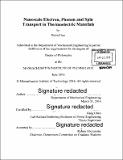| dc.contributor.advisor | Gang Chen. | en_US |
| dc.contributor.author | Liao, Bolin, Ph. D. Massachusetts Institute of Technology | en_US |
| dc.contributor.other | Massachusetts Institute of Technology. Department of Mechanical Engineering. | en_US |
| dc.date.accessioned | 2016-09-13T19:15:15Z | |
| dc.date.available | 2016-09-13T19:15:15Z | |
| dc.date.copyright | 2016 | en_US |
| dc.date.issued | 2016 | en_US |
| dc.identifier.uri | http://hdl.handle.net/1721.1/104231 | |
| dc.description | Thesis: Ph. D., Massachusetts Institute of Technology, Department of Mechanical Engineering, 2016. | en_US |
| dc.description | Cataloged from PDF version of thesis. | en_US |
| dc.description | Includes bibliographical references (pages 133-146). | en_US |
| dc.description.abstract | Climate change is among the most critical challenges that are facing the human race in the 21st century. One of the major factors that leads to climate change is the increasing consumption of fossil fuels, driven by industrialization and economic growth at an unprecedented pace. For a secure and sustainable future of energy and the environment, new clean and efficient energy technologies are in urgent need. Thermoelectric materials are a group of materials that can directly convert heat into electricity. Being solid state, clean, reliable and without moving parts, thermoelectric energy conversion holds great promise as a candidate technology to harvest energy from thermal sources, such as the sun and terrestrial heat sources, as well as improve the efficiency of existing energy systems by recycling the inevitable waste heat. The bottleneck that prevents large-scale deployment of thermoelectric modules so far, however, is the relatively low efficiency and high cost. A good thermoelectric material needs to conduct electricity well and conduct heat poorly to attain high efficiency. Remarkable progress has been made in the past decade to decouple the charge and heat transport and thus improve the material performance. Most of the progress has been based on a more detailed understanding of the transport and interaction of fundamental energy carriers, such as electrons and phonons in most semiconductors, and magnons in magnetic materials. These understandings have been achieved through the development of both first-principles simulations and experimental spectroscopic tools, in particular for phonon transport and phonon-phonon interaction, which have enabled calculations and measurements at the single-phonon-mode level. Information gained from these studies formed the foundation of the successful engineering efforts of designing nanostructured thermoelectric materials. Although the nanostructuring approach has been able to reduce the thermal conductivity of thermoelectric materials down to proximity of the amorphous limit, it has been realized by the community that further improvement of thermoelectric materials requires breakthroughs in boosting the electrical transport properties, including the electrical conductivity and the Seebeck coefficient. Despite several existing strategies, a prerequisite for systematic improvement is, again, insight into the transport and interaction of fundamental carriers, particularly involving electrons, at the single-mode level. This insight has largely remained lacking in terms of electrons, both on the simulation side and on the experimental side. This thesis aims to develop both simulation and experimental tools to study nanoscale electron, phonon and magnon transport and their interactions, with a particular emphasis on understanding the electron-phonon interaction at the single-mode level. This is among the most important forms of carrier interactions and determines the intrinsic electron transport properties of most conductors. Regarding phonon transport, we applied first-principles lattice dynamics to study phonon-phonon interaction and lattice thermal conductivity in a strongly-correlated thermoelectric compound FeSb 2. On electronphonon interactions, we studied from first-principles the intrinsic electrical transport properties of phosphorene, which are limited by electron-phonon interactions, analyzed its anisotropy and evaluated its potential as a thermoelectric material; we studied how free carriers can in turn scatter phonons through the electron-phonon interaction and reduce the lattice thermal conductivity; to verify this finding, we designed an ultrafast photoacoustic spectroscopic technique to directly detect the damping of a single phonon mode due to electron-phonon interaction. On phonon-magnon interactions, we applied the coupled Boltzmann equation to analyze coupled phonon-magnon diffusion and proposed a novel magnon cooling effect. These fundamental discoveries can potentially lead to new design principles for more efficient thermoelectric materials in the future. | en_US |
| dc.description.statementofresponsibility | by Bolin Liao. | en_US |
| dc.format.extent | 146 pages | en_US |
| dc.language.iso | eng | en_US |
| dc.publisher | Massachusetts Institute of Technology | en_US |
| dc.rights | M.I.T. theses are protected by copyright. They may be viewed from this source for any purpose, but reproduction or distribution in any format is prohibited without written permission. See provided URL for inquiries about permission. | en_US |
| dc.rights.uri | http://dspace.mit.edu/handle/1721.1/7582 | en_US |
| dc.subject | Mechanical Engineering. | en_US |
| dc.title | Nanoscale electron, phonon and spin transport in thermoelectric materials | en_US |
| dc.type | Thesis | en_US |
| dc.description.degree | Ph. D. | en_US |
| dc.contributor.department | Massachusetts Institute of Technology. Department of Mechanical Engineering | |
| dc.identifier.oclc | 958142737 | en_US |
